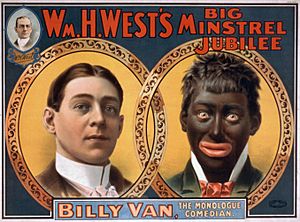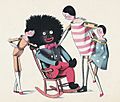Blackface facts for kids

Blackface is a type of makeup or costume. Non-Black performers used blackface to pretend to be Black or African American people. This was done to create stereotypes, which are unfair and untrue ideas about a group of people.
Blackface became very popular in the 1800s, especially after the American Civil War. It helped spread harmful stereotypes, like the idea that Black people on plantations were always happy.
By the mid-1800s, blackface was a big part of minstrel shows. These shows were a type of entertainment where white performers often made fun of Black people. They would use blackface to look like Black people and act out these stereotypes.
In the early 1900s, blackface started to be used outside of minstrel shows. It became a common way for performers to act in movies and on stage.
In the United States, blackface became much less popular after the Civil Rights Movement. This movement in the 1950s and 1960s fought for equal rights for all people, especially African Americans.
Today, blackface is seen as very offensive, disrespectful, and racist. It reminds people of a time when Black people were treated unfairly and mocked.
Contents
What is Blackface?
Blackface is when a person, usually a white person, paints their face with dark makeup. They also often wear costumes and act in ways that make fun of Black people. This was a common form of entertainment in the past.
It was not just about changing skin color. Performers would also exaggerate features like lips and hair. They would act in ways that were silly or foolish. This made Black people seem less intelligent or capable.
History of Blackface
Blackface started in the early 1800s in the United States. It grew into a popular form of entertainment called minstrel shows. These shows often featured white performers in blackface.
These shows were very popular for many years. They spread harmful ideas about Black people across the country. Even after slavery ended, blackface continued to promote racist stereotypes.
Blackface in Minstrel Shows
Minstrel shows were a big part of American entertainment in the 19th century. They included music, dancing, and comedy. But a main part of these shows was blackface.
Performers would put on blackface makeup and act out characters. These characters were often based on racist stereotypes. They showed Black people as lazy, ignorant, or always happy, even when they were suffering.
Blackface in Movies and TV
As movies and television became popular, blackface moved from the stage to the screen. Many early films and TV shows featured actors in blackface. This continued to spread racist images to a wider audience.
Famous actors and singers sometimes used blackface in their performances. This made it seem more acceptable. However, many people, especially Black communities, found it deeply hurtful.
Why Blackface is Harmful
Blackface is harmful because it is based on racism. It makes fun of a group of people based on their race. It also promotes untrue and negative ideas about them.
It reminds people of a time when Black people were treated as less than human. It was used to justify slavery and segregation. Even today, it brings up painful memories and feelings for many people.
Using blackface today is seen as very offensive. It shows a lack of understanding about history and racism. It can cause a lot of hurt and anger.
Images for kids
-
An old advertisement by Dr. Seuss showing a character in blackface.
-
Singer and actor Al Jolson wearing blackface in the 1930 film Mammy.
-
A poster for Spike Lee's movie Bamboozled from 2000. This film is about blackface.
-
A poster for the 1939 Broadway show The Hot Mikado, which used blackface.
-
A drawing of a "Golliwog" from 1895. This character was described as a "horrid sight" and wore minstrel show clothes.
See also
 In Spanish: Blackface para niños
In Spanish: Blackface para niños










